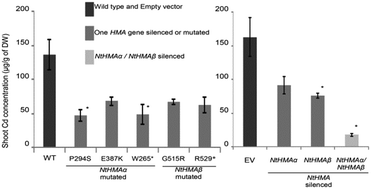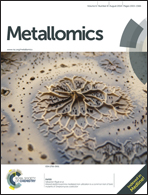Inactivation of two newly identified tobacco heavy metal ATPases leads to reduced Zn and Cd accumulation in shoots and reduced pollen germination†
Abstract
Cadmium (Cd) is a non-essential heavy metal, which is classified as a “known human carcinogen” by the International Agency for Research on Cancer (IARC). Understanding the mechanisms controlling Cd distribution in planta is essential to develop phytoremediation approaches as well as for food safety. Unlike most other plants, tobacco (Nicotiana tabacum) plants translocate most of the Cd taken up from the soil, out of the roots and into the shoots, leading to high Cd accumulation in tobacco shoots. Two orthologs of the Arabidopsis thaliana HMA2 and HMA4 Zn and Cd ATPases that are responsible for zinc (Zn) and Cd translocation from roots to shoots were identified in tobacco and sequenced. These genes, named NtHMAα and NtHMAβ, were more highly expressed in roots than in shoots. NtHMAα was expressed in the vascular tissues of both roots and leaves as well as in anthers. No visual difference was observed between wild-type plants and plants in which the NtHMAα and NtHMAβ genes were either mutated or silenced. These mutants showed reduced Zn and Cd accumulation in shoots as well as increased Cd tolerance. When both NtHMA genes were silenced, plant development was altered and pollen germination was severely impaired due to Zn deficiency. Interestingly, seeds from these lines also showed decreased Zn concentration but increased iron (Fe) concentration.


 Please wait while we load your content...
Please wait while we load your content...